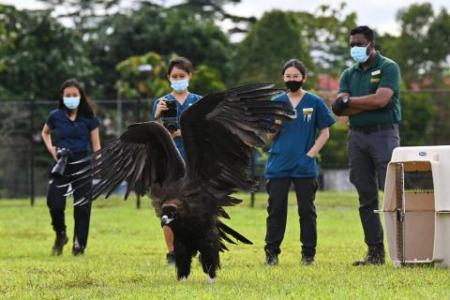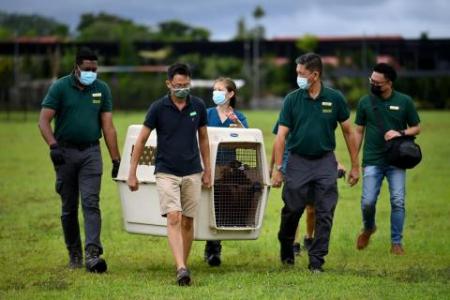Rare cinereous vulture fails to fly after release attempt
The rare cinereous vulture found near Singapore Botanic Gardens remains in Singapore after it failed on Tuesday (Jan 4) to take flight despite being assessed to be strong enough to do so.
The migratory bird - Singapore's first record of the largest raptor in Europe, Asia and Africa - had been hospitalised at Jurong Bird Park's bird hospital since last Thursday.
The hefty bird remained grounded on Tuesday morning despite encouragement from National Parks Board (NParks) and Mandai Wildlife Group staff, and after about 30 minutes, it was taken away for further recuperation.
Deputy Vice-President for Conservation, Research & Veterinary of Mandai Wildlife Group Xie Shangzhe told The Straits Times that no abnormalities or injuries were detected when the scavenger was first checked by Jurong Bird Park's avian veterinarian team.
They had conducted full body x-rays, a blood cell count and organ function tests.
Dr Xie said the scavenger was most likely exhausted - a common challenge for migratory birds - from flying long distances and needed to replenish its energy reserves.
Thousands of birds like the vulture migrate to warmer regions to avoid cold winters in parts of the world during the yearly migratory season, which takes place between September and March.
NParks' group director of wildlife management Adrian Loo said Singapore is an important stopover for these birds as it is part of the East Asian-Australasian Flyway - a migratory route that stretches from the Arctic through Russia and Alaska, to Australia and New Zealand, encompassing 22 countries - and the Central Asian Flyway, which includes the Himalayas where the cinereous vulture can be found.
The sooty species, native to Europe and northern Asia, is vagrant to South-east Asia, said Dr Loo. This means the bird has flown off-course or was blown off-course.
It usually spends winters in northern India, the Middle East and occasionally South Korea, he added.
Annually, Jurong Bird Park's hospital receive an estimated 200 rescued birds comprising both native and migratory species, said Dr Xie.
When the vulture first arrived at the bird hospital last Thursday, the raptor was lying on its side weakly and was given fluid therapy, he said.
By the next day, the vulture could stand well on its own and was fed boneless meat.
Once the bird had enough energy and could use its legs to break down large pieces of bone, it was fed up to about 600g of red meat with bone a day.
Migratory birds at Singapore's bird hospital are not common, noted Dr Xie, adding that majority of these creatures are treated for exhaustion or sustained traumatic injuries from predator wounds or vehicle collisions.
Wherever possible, they will be released back to their natural habitats, usually within a day if they are healthy, he added.

There are rare instances, however, where a bird may be absorbed into Mandai Wildlife Group's parks if they require long-time care and monitoring, said Dr Xie.
In 2005, a Himalayan griffon vulture named Genghis was rescued at Nanyang Girls' High School after it was seen vomiting.
The scavenger has remained under the care of the park's Animal Presentation team after it was treated and rehabilitated.
Members of the public should contact NParks or Animal Concerns Research and Education Society (Acres) when they encounter an injured bird or any animal requiring assistance.
They should not approach, provoke or feed the animal, and follow the instructions of the NParks or Acres officer on the phone.
The public may contact NParks at 1800-471-7300 or Acres at 97837782.Bird photographers such as the crowd of about 50 enthusiasts seen shooting the vulture last Thursday are also advised by NParks to be socially responsible and observe safe management measures.
Challenges faced by migratory birds
1. Exhaustion and starvation.
While tiredness and hunger is commonly observed, this tends to plague larger flocks, said Dr Xie.
"The larger the group of migratory flock, the greater the competition among them for similar resources," he said.
2. Collisions
"All birds can potentially crash into obstacles such as tall buildings, but as migratory birds tend to fly in larger flocks, this may be more problematic as it affects a larger number of birds when it happens," said Dr Xie.
3. Predators
Other animals may attack the migratory birds which may not be as familiar with this threat and therefore be at greater risk of being eaten, said Dr Xie.
4. Climate change
"The increased unpredictability of the weather and frequency of inclement weather results in unfamiliar patterns in the flight paths of migratory birds," said Dr Xie.
This may result in them needing to fly longer distances and lead to exhaustion.
Changes in weather patterns also affect the patterns of disease distribution which may result in migratory birds being exposed to diseases that can impact their health.
Get The New Paper on your phone with the free TNP app. Download from the Apple App Store or Google Play Store now



